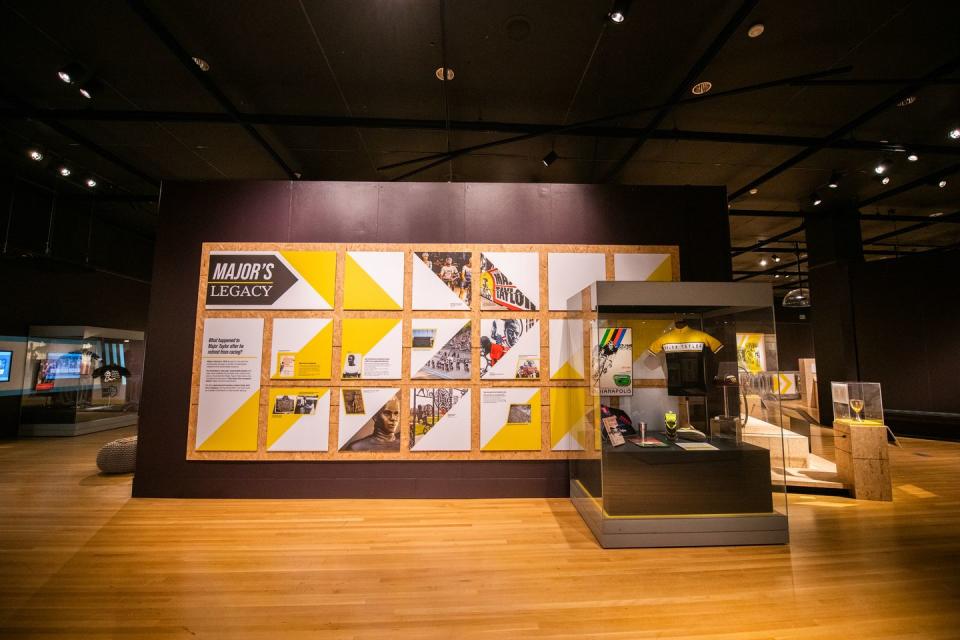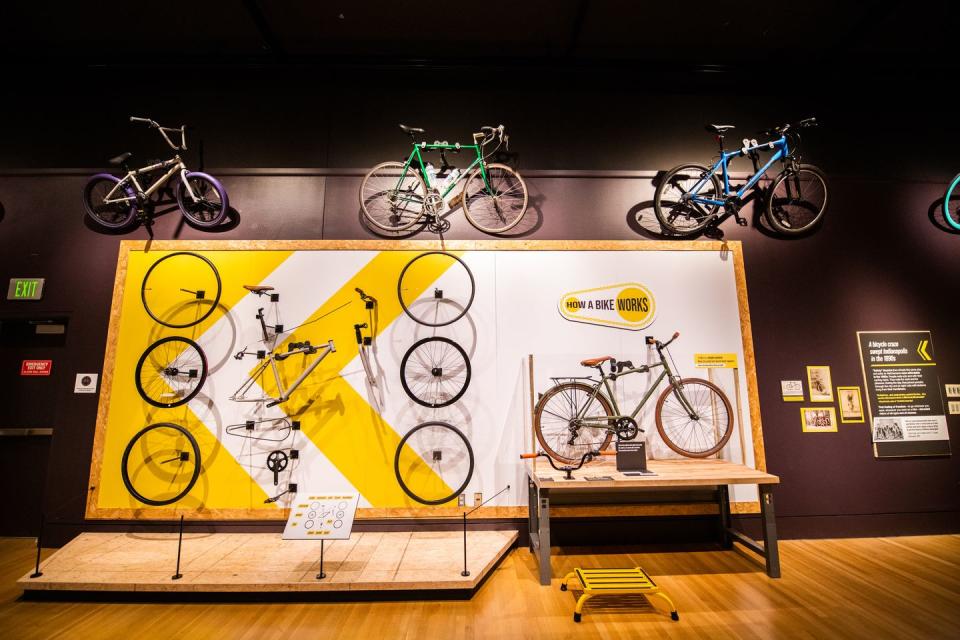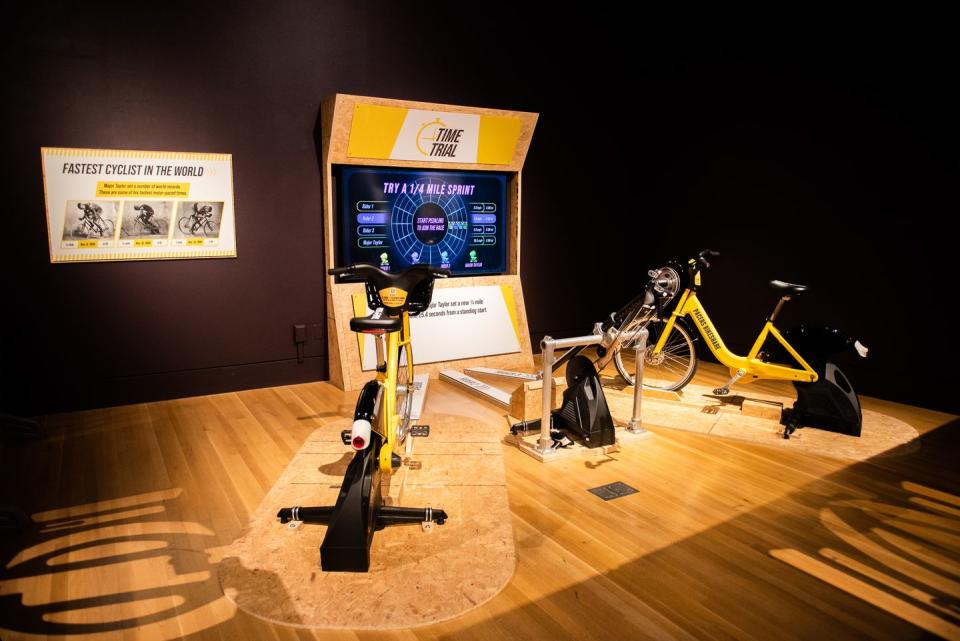Take a Look Inside the Major Taylor Exhibit at the Indiana State Museum

- Oops!Something went wrong.Please try again later.
An exhibit at the Indiana State Museum in Indianapolis shines a light on the life and career of Indiana-born cyclist Marshall “Major” Taylor, the first Black cyclist (and second Black athlete ever) to win a world championship. The exhibit, Major Taylor: Fastest Cyclist In The World, is currently open and on display until October 23 of this year.
Taylor broke down barriers, bypassed rules of segregation in track cycling, and pushed back when knocked down—sometimes literally. He faced an incredible amount of discrimination during his career as a professional cyclist, and the exhibit covers it all: From the intimate letters he wrote to his wife, Daisy, and daughter, Rita Sydney, while traveling abroad for races, to the detailed documentation saved in his numerous scrapbooks.
You love cycling. We love cycling! Come join us at Bicycling All Access
“The Major Taylor exhibition is an exceptional tribute to my great-grandfather,” Taylor’s great-granddaughter Karen Donovan told Bicycling. “The pride I feel for his accomplishments is endless, and I am so grateful for the dedication of the numerous individuals who brought this project forward… The exhibition highlights not only Major’s life story, but also the perseverance that helped him to achieve his goals.”
Taylor was born in 1878 and was spotted as an extraordinary talent after doing some tricks on a bicycle at a local shop in Indianapolis. He was hired to clean the shop, do tricks to attract customers, and was also given a bicycle. Taylor worked at two local shops, the second of which is where he taught others how to ride. In 1892 or early 1893, he met former racer Louis D. “Birdie” Munger, who had established Munger Cycle Manufacturing Company and ended up mentoring the young cyclist.
There is no doubt that Taylor was an elegant man. The photographs he appears in are telling of his perseverance and panache. His stance is strong and steady, as is his gaze. During one’s lifetime, one may not be aware of the legacy they are trailblazing, and often such titles are given postmortem. However, Taylor knew that what he was doing was going to change the world of cycling forever, and sure enough it did.

Walking through the exhibit and seeing one of his bicycles, a Peugeot on loan from the U.S. Bicycling Hall of Fame, it’s impossible not to feel awe. Taylor was a man who rewrote the record books. Two of his trophies are on view: one from a race in Berlin, where he beat German national champion Willy Arend in 1901, and the other from Paris, dated May 27, 1904. At a time in the world when racism was rampant in the United States, his trophies, his recognition, and his achievements mean so much more than the shiny objects that remain.
Taylor worked hard for his wins. He rode on “his wheel” daily and had a rigorous training schedule that also included boxing, weightlifting, and eating a protein-heavy diet. All this aside, the exhibit touches on how he must have had to train his mind, too. Taylor was hyperaware of the challenges he faced, and his scrapbooks tell the tale in black and white: The numerous newspaper clippings depict his global travels, races, wins, and biggest competitors, but also document the way he was portrayed in racist newspaper comics.
The exhibit has one section that comes with a warning. There is an armoire with two doors that can be opened voluntarily, but with a note about the severity of the content within. Taylor was mocked and drawn in a horribly racist and stereotypical fashion, the cadence of his voice written out in text above the caricatures as if to make him sound uneducated. This is one of the dark moments of the exhibit, which does a marvelous job at showing us the valleys that lead to his fortitude.
While Indiana has produced many wins politically and historically, there is also a darkness to its history as the state is the birthplace of a branch of the Ku Klux Klan. After finding early success in his career in Indiana, Taylor decided to leave the state, in part due to the burgeoning racism and general feeling of being unwelcome. He and Munger, who had taken Taylor under his wing at that point, relocated to Massachusetts. They then traveled to France, Italy, Germany, England, Australia, and many other counties in pursuit of wins.

Kisha Tandy, curator of social history at the Indiana State Museum, did research delving into the complicated and legacy-filled life of Taylor. She reflected on her experience with this material, the importance of showing it in 2022, and what it means for Indianapolis, today.
“Looking at his life and the historical significance of it—his career and legacy—and the fact that he overcame what he called ‘the dreadful monster prejudice’ and discrimination from other cyclists, is a huge inspiration for us today,” Tandy told Bicycling. “It’s a history lesson, as well as a story about sportsmanship and athletics, a chance to look back, to reflect using Major Taylor’s life to visit various points in history.”

The museum collaborated with local artists who painted Taylor’s likeness, a local voice actor to read his letters, and a photographer who photographed Black cyclists based in the city. The exhibit has staff on hand to help teach visitors how to change a flat tire and build a bike or scooter using a pre-fab kit. In the back lefthand side of the gallery, three bicycles (two leg-operated and one-hand operated) sit on trainers as a way to “race” Taylor video-game style. The program doesn’t have the quality or precision of Zwift, a popular virtual cycling platform, but it can demonstrate the speed at which Taylor traveled on a singlespeed bike.

Today, Major Taylor cycling clubs exist all over the country. Visiting any metropolis, one is likely to spot a rider decked out in their Major Taylor kit blazing by.
“I’m thrilled to see the Indiana State Museum produce an exhibit on Major Taylor,” Justin Williams, founder of the dominant crit-racing team L39ION of Los Angeles, told Bicycling. “The first team I ever joined, Major Motion, was named after him, and his silhouette was featured on my jersey until I went pro. I’m fortunate to have learned about his story at a young age, and his legacy has continued to inspire and motivate me whenever I’ve faced adversity in the sport. My hope is that cyclists from all levels and backgrounds have an opportunity to visit the space and learn about Major’s remarkable story.”
Black cyclists carry this brightly lit torch forward today. BIPOC groups in New York City, such as The Century Plus Crew (known for their 100 mile rides), Black Girls Do Bike, and of course Major Taylor Iron Riders, sprint forward whether on flat or clipless pedals. They encourage all riders to join them, creating a safe environment for those who feel marginalized by the cycling community to claim space. Major Taylor did just that. He not only claimed space but put a stake in it and declared it his own.
“Major Taylor Iron Riders’s name is derived from Marshall ‘Major’ Taylor and the Buffalo Soldiers Bicycle Corps of 1890,” Dereka Hendon-Barnes, president of the Major Taylor Iron Riders of New York City, told Bicycling. “Both endured unimaginable obstacles but still managed to complete the challenges before them. Major Taylor Iron Riders is a NYC-based cycling club founded in 2006. It creates a space for people of color and has cultivated an inclusive and diverse cycling community. We ride to honor Major Taylor’s name and take the responsibility to share our love of riding bikes.”
Taylor passed in 1932 at the age of 53 after a brief illness, during the Great Depression. He had retired from cycling in 1910 and fought body aches and pains, but also struggled with the need to support his family in a time of economic strife. He died in Chicago and was placed in an unmarked grave weeks before his wife and daughter knew of his death.
The heartbreaking end to his journey did not pass in vain. While his final days and bank account sadly did not reflect the triumphs of youth, his wisdom and legacy would not be erased. Instead, his efforts continue to be recognized to this day. So the next time you see a cyclist in a Major Taylor kit, take a moment to pause and reflect on the incredible athlete and hero they represent.
You Might Also Like

